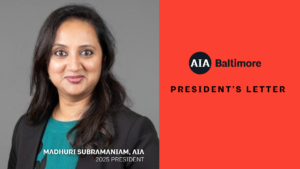 Over the years, one of the most fair-minded criticisms of AIA has been of an organization whose focus is a mile wide and an inch deep. In response to membership, AIA pursued advocacy, research, collaboration and celebrated the many unique challenges and successes that we faced in daily practice. This approach led to lots of unique reports, collaborations, events, (and most importantly) knowledge. However, these pieces were isolated by building typology, differences in practice, geography, etc. and were rarely communicated across these boundaries.
Over the years, one of the most fair-minded criticisms of AIA has been of an organization whose focus is a mile wide and an inch deep. In response to membership, AIA pursued advocacy, research, collaboration and celebrated the many unique challenges and successes that we faced in daily practice. This approach led to lots of unique reports, collaborations, events, (and most importantly) knowledge. However, these pieces were isolated by building typology, differences in practice, geography, etc. and were rarely communicated across these boundaries.
In 2019, the AIA National Board of Directors rolled out the “Big Move.” It formalized and redirected AIA’s knowledge, content and resources towards one issue—climate action. The board’s idea was to focus its work, dollars, staff and volunteers towards this issue. No longer would AIA’s attention be a mile wide and an inch deep; we would be laser focused on a singular cause.
As some of you may know, I grew up in Missouri, the Show Me State. After reading about the “Big Move” I was skeptical AIA could create and maintain a disciplined focus on a singular topic. I would have to see it to believe it. I suspect some of you had the similar reservations.
Last month, I attended the 2020 Grassroots leadership conference in New Orleans. This annual event brings together over 600 national, state and local AIA leaders. This year’s conference was focused on climate action, specifically around three measures within the Framework for Design Excellence: Equitable Communities, Economy, and Energy. The keynote speakers, candidates for national office, and AIA leaders themselves all framed their discussions around climate action. Presenters in the daily breakout sessions told stories from their communities about specific actions they were taking in reference to one of these three measures. Each of these sessions was unique, but they all had a united focus, climate action.
The boundaries of building typology, practice and geography were no longer prohibiting action, but illustrating the many ways architects can act towards a singular focus—climate action. It was a refreshing to see at a national scale, an organization focused on a specific issue, not specific solutions. In New Orleans, I also saw how local chapters are refocusing their efforts, programs, and dollars towards climate action.
AIA Baltimore is doing the same. In just the month of March alone, the Committee for Architecture and Education (CAE) will be releasing the first in a series of interviews with Sustainability Directors from local firms. The Health and Wellness Committee’s annual Design Showcase being held on March 11 promotes health and wellness in a variety of creative and impactful ways by sharing best practices, strategizing solutions and discussing adaptation. The COTE+R Committee is hosting its COTE Top 10 Toolkit – Framework for Design Excellence Workshop on March 17th.
I am cautious by nature. I did grow up in Missouri and abide by our state motto. The work we are doing here at AIA Baltimore, and AIA National’s sustained focused makes me believe we have turned a proverbial corner on climate action.
The most important step on any journey is the first. I believe we have taken that step. I see urgency and focus in all AIA levels regarding climate action.
AIA Climate Action Resources
Climate Change Adaptation Design Resources
Framework for Design Excellence
Architecture 2030
The State of the AIA’s Sustainability Agenda with Tom Liebel, FAIA – March 25

Scott M Walters, AIA, LEED AP
Hord Coplan Macht
